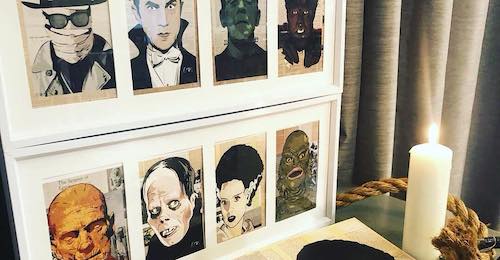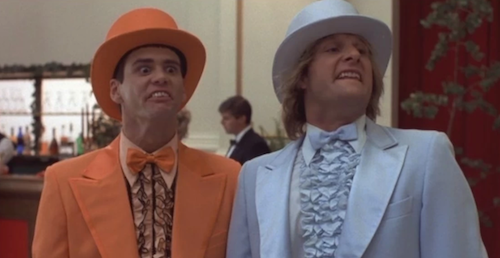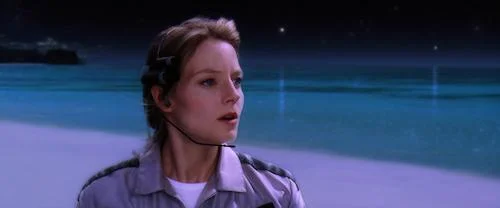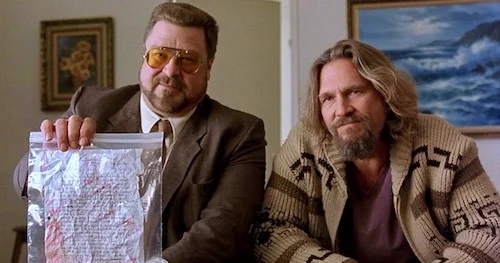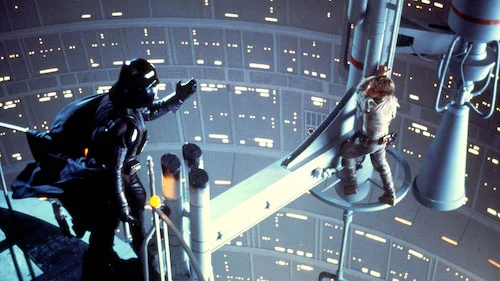Daniel Turres and Pop Fiction: The Turning Of Motion Pictures into a Single Artwork.
You know you have a great idea, when audiences of all sorts flock to your booth, fighting their way to talk cinema with the lead artist. Daniel Turres is the mastermind behind the illustration phenomenon “Pop Fiction”. This company combines two brilliant ideas: the purchasability of recognizable images, and the sentimentality of an artist’s rendering. Those two notions (relatability, and an interpretation) are the pure essences of why pop culture movements take off the way that they do; we can all agree on the objects of our fanaticism, and it means something differently to each of us. His artwork ranges from South Park and Rick & Morty, to classic movie monsters and villains. Usually, each theme comes in a pack of four images (perfect for shows like Seinfeld or Riverdale, that contain four recognizable leads), but individual pieces can be purchased.
Turres has a background in both filmmaking and the visual arts, so putting the two together was a no brainer. I had the privilege of going wild with my obsession of cinema with Turres (who patiently allowed me to talk everything film) at the Canadian National Exhibition (CNE): an annual festival that mixes personal artistry with carnivals, midway games, farms, and warehouse sales. Months later, Turres granted me the opportunity to discuss Pop Fiction. The extra bonus was being able to gush over why I loved the pieces I myself purchased from him (not included in the transcription to save space).
Be sure to visit Pop Fiction’s Etsy store to purchase prints, its Facebook page for updates, and the Instagram page for hilarious promotional videos.
Films Fatale: How did you get the inspiration to do Pop Fiction? Where did it all start?
Daniel Turres: It starts with my previous job. I used to work sales at craft shows. I really enjoyed it. I got to travel a lot. I got to travel to the states a lot to sell craft. When I quit that job, I wanted to do that same type of career choice, where I travel, set up and sell my product. I wanted to do products that I’m passionate about. I’m very passionate about pop culture in every format. T.V., film, books. I started to draw. I didn’t realize that it would work so well, that it works all year round. I can do comic cons, collector shows, craft shows; Christmas shows are really fun, too. I have a background in fine art, and I thought I might combine that with my skills as a storyboard artist and start making some type of product out of my art, and it kind of blew up really nicely.
FF: You bring up your fine art background, and you have a very distinct style with all of your pieces. Is that how you’ve always drawn, or is it something you had to approach differently with all of the subjects you were depicting?
DT: That’s a good question. I did have to learn some learning curves and get back into it. I was doing a lot of graphic design for advertising to get by sometimes. I combined a lot of my skills with line work and proportions, learning what it takes to illustrate and then combine it with a digital format. So that was kind of a learning curve. I’ve always been proficient with Photoshop; I used to do a lot of wedding photography, so Photoshop was something I had handy. I tell people I combined a lot of classical traditional, with new age techniques. I think it’s kind of a blend of bringing the old and new together.
FF: You’ve brought up your love for film and television; we’ll stick primarily with those, partially because they are visual mediums. How long ago did that start, where you weren’t just watching movies, but you were actively dissecting them and viewing them through an academic lens, like you are now?
DT: My family’s been extremely supportive. They’re probably the reason why I am so enthused by film. They would tell me things, like, behind the scenes of the shots [that I would watch]; I must have been about early elementary school, maybe grade six or seven. Probably even earlier, because I began doing my own film projects around that time, so I’m guessing around [age] ten or eleven. My dad was telling me if things got shot chronologically, continuity errors, special effects in films. That was always exciting to learn at such a young age.
FF: Did your father take part in the film industry, or was he just an aficionado?
DT: At that point, he was just an aficionado, as you said. However, he’s [now] a screenwriter, he’s been writing several scripts for stuff. Recently, we’ve gotten into co-producing together as a team, with films back in our home country of Chile.
FF: You’re bringing up your actual filmmaking. How did that start? What exactly are you doing?
DT: Probably like most; with your classic short films for school projects. Particularly, when you take film courses and you’re challenged to do small short films. Before I went to film school, I produced a feature film when I was eighteen. Back when I was in London. I said “you know what? I’m gonna try something”, and I did it. It didn’t succeed as much as I had wanted, but we went through with it. It’s called Terry’s Car Gets Stolen. It was such an amazing experience working with such a variety of different, talented people. It was mixing new and old friends together, so it was incredible. After that, several more short films, and I won a few awards. Right now, the new project is a short horror-comedy that we’re working on for upcoming film festivals.
FF: It’s interesting that your expertise seems to lie within short films, which I believe gets a massive under-appreciation with the mainstream. Now with social media, we have the late Vine app, Instagram stories and more. There seems to be a new light shed on this idea. They’re not short films, though. With Pop Fiction, a lot of work goes into making these parodic tributes for whatever artwork you’re promoting. How much of your short film experience goes into your viral videos?
DT: The viral videos? The mistakes I used to make when I used to make short films (or when I would work on other people’s films), help a lot with knowing what to improve upon in the future. My goal when we make a viral film -- there was a lot of research that went into finding what makes a viral video. What I found is “less is more”. I try to think of a joke, some type of sense of humour, for a specific skit, and how I can convey that with at least just one shot. We have an attention span in this day and age. We’re more likely to watch a thirty second video than we would for a ten minute video now. It’s such a fast, mainstream society that we live in now. So, I try to think of “how I can convey this humour”. Sometimes, I have to think of an elaborate story idea, and then cut down the main parts to it; shave away down to the core aspect, what’s going to deliver, and what are people going to really catch?
FF: You can almost argue that your artwork is within the same guidelines. What can something capture in the shortest amount of time; in this case, it’s a single frame. How do you go about picking specific shots for particular subjects?
DT: It’s a really tricky line when I do my artwork, because you have to sell it so it’s not just [made] for one person. You have to make sure that anybody can look at that piece and feel like they can put it on their wall. Sometimes when I go to a comic con and I see a specific piece that I like, and… Less is more. That’s my technique. If you notice, [my work’s made up of] very few lines, and its more different layers of colours, it’s very cleanly cut. I think that add a layer of…
FF: Familiarity, because there is less for the viewer to analyze?
DT: Exactly! Less is more is what I go for with my artwork.
FF: In regards to this day and age, you brought up how the shorter the video, the more likely it’s going to get hits, as we have a short attention span. You look at basic emojis, where you kind of have something similar. You have simple images that draw a huge response from people.
DT: I agree completely.
FF: How long have you been Pop Fiction for? A couple of years?
DT: Right now, we’re coming up to two years now. Wow! Holy! Years go by faster when you get older, don’t they?
FF: To be fair, your company is two years old, and you’ve exploded this much. That’s a fast rate!
DT: Thank you! I had a goal in mind. Because of the experience I’ve had with films and other projects, I thought “You know what? I think if I push and work hard enough, I can do it myself”. I started off with a small table, with twenty eight drawings. The response is fantastic! If you had met me two years ago in March, it would have looked like a different set up than what you saw at the CNE. There was a goal in my mind, for sure.
FF: How do you approach new designs and where to go next? Do you take the Pop! Vinyl approach where you tap into the current trends, or do you have a personal approach (with what you want to see)?
DT: I have to say it’s probably a mixture. I find that people enjoy the nostalgia of things, even when they’re hard to find. One of my favourite ones that nobody asked me about was Monty Python and The Holy Grail. One of my favourite movies. I thought “I’d love to just see how I could draw them”. It turned out to be a nice, big hit when I finished drawing it. Right now, I’m actually working on Brooklyn Nine-Nine. I really like the show, and I’ve been asked for it a lot. Most of the time, I like listening to my fans and customers that ask “Hey, what’s the next piece gonna be?”. I can be current, but it’s also cool to bring in nostalgia. The next thing after Brooklyn Nine-Nine – I haven’t had a chance to, I’ve been dying to do it—is my mafia set. There are some classic mafia films out there that I can see need to be given their homage!
FF: You love pop culture, but your knowledge of cinema expands past that. Do you ever intend on drawing images on a work that’s not a part of a zeitgeist? Like Raise the Red Lantern or Cinema Paradisio which, obviously, have their own fan bases but not in the same way that South Park does?
DT: What’s fun about it, is I get asked for music-related stuff all the time, because that’s a huge part of my life. Music affects film, and works well on its own, it’s universal. I like to keep a nice balance between, like – I’ve got a movie one, I’ve got a TV show one, I’ve got a video game one—like, pop culture has such a broad spectrum and there’s so much more [material] that we are a fan of [to pick from].
FF: You’ve had an involvement with (now) Academy Award winning director Guillermo Del Toro. How did that happen? Is he a nice guy?
DT: My uncle met him. He’s an animator in Toronto. He had a chance to meet him. Because of our background, there was a bridge there that was really nice to get acquainted with. When we had the opportunity to, we went to the Guillermo Del Toro exhibition that was at the AGO (Art Gallery of Ontario). That was an incredible and invaluable experience. I’ve always been a big fan of his. I’ve always been truly inspired by him. I find that most of his work has a certain feel to it than some other horrors, classic thrillers. He has a poetry to his films.
FF: We can expect some Pop Fiction art for The Shape of Water or Pan’s Labyrinth?
DT: Yes. Definitely. I would definitely expect that coming up. A Shape of Water one would be great. For Pan’s Labyrinth, I was thinking of drawing the faun, because it has a whole bunch of different textures. I have to figure out how I am going to draw that. I love the ghosts in Crimson Peak. The look of those is really striking. The contrast between the Victorian dark age and the dark red… I really like The Strain. The way he does his vampires. There is a Guillermo Del Toro piece coming up, and it will take longer than the others, because of how much I want to make sure it looks good (for Guillermo Del Toro’s sake).
FF: Any future plans for Pop Fiction (new designs, or even new concepts)?
DT: We have some ideas. One is different types of events and shows to be a part of. Different markets we haven’t tapped into yet. Most of the times I’ve drawn only people. I want to start drawing vehicles and ships, because that’s something I’ve been requested [to do], and I would really enjoy. The first one I have drawn so far is the Delorean. That itself is like a character in Back to the Future, design wise and how relevant it is to the plot. I’m not sure which [other vehicles] yet, because I’m going to try them first on my own here to see if it’s viable. Because of how young Pop Fiction is, there’s so much potential for what it could be three years or five years from now.
Turres’ work being featured in Cineplex Magazine.
FF: Pop Fiction is so young, but you’ve already been featured in Cineplex Magazine. How did that even happen? How does it feel to be spot lit like this?
DT: That was an exciting time. I was in disbelief. I try to do a good presentation when I’m at a show. I got noticed in Toronto’s CNE, which is a very big event which happens for eighteen days straight. Millions of people come in through there. I talk to thousands of different people in a day. I guess I talked to somebody who I didn’t realize worked as a reporter for Cineplex Magazine. They were doing a piece called “The Art of Film”. I was just in the zone talking about my artwork, not really realizing that this is a reporter. Later on, that same reporter contacted me. They said “Hey, I talked to you at the show. Do you want to be a part of ‘The Art of Film’?” I said “What?”, because this is an article I always read! Of course I would!
It felt really good to be recognized, and all of the hard work I’ve been putting into this is really paying off; not just as a business, but emotionally, as well.
FF: We like to send interviews off with the most basic question, based on why we are all cinephiles. What are your top five films of all time, and why?
1. Dumb & Dumber
DT: I like movies that I can watch over and over, and never get tired of. It’s a silly one. I can watch that over and over, and just still laugh at all of the jokes.
2. Contact
DT: One of my favourites that is a sci-fi but in a simple way is Contact, with Jodie Foster and Matthew McConaughey. Always been amazed by how thrilling a film is with very little sci-fi visuals in the film.
3. The Big Lebowski
DT: I’m a big fan of the Coen Brothers stuff. I’m trying to figure out which Coen Brothers movie that I like [the most]! I’m gonna say The Big Lebowski. It’s got all of the ups and downs. The humour and the dialogue is just incredible.
4. Pan’s Labyrinth
DT: Going back to Guillermo Del Toro, The Shape of Water is great. A really fantastic movie. But I have a Latino background, so Pan’s Labyrinth really hits home for me.
5. Star Wars: The Empire Strikes Back
DT: I don’t want to be cliché, but The Empire Strikes Back. I don’t know why George Lucas doesn’t realize how well he made his movies when they first came out. They didn’t need to be remastered or anything. They were great. It’s a film where nobody wins in the end of that movie, and I like movies where there’s not, like, a happy ending.
Films Fatale thanks Daniel Turres for sharing his experiences with us. Once again, head over to Pop Fiction’s Etsy Store to purchase prints (like the many works seen above, and much more), and follow Pop Fiction on both Facebook and Instagram for updates on new art pieces.
Andreas Babiolakis has a Masters degree in Film and Photography Preservation and Collections management from Ryerson University, as well as a Bachelors degree in Cinema Studies from York University. His favourite times of year are the Criterion Collection flash sales and the annual Toronto International Film Festival.


